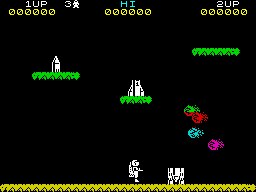Jetpac
| Jet Pac | |
|---|---|
 Jet Pac ZX Spectrum cover | |
| Developer(s) | Tim and Chris Stamper |
| Publisher(s) | Ultimate Play the Game |
| Platform(s) | ZX Spectrum, BBC Micro, Commodore VIC-20, Xbox One |
| Release | ZX Spectrum May 1983,[1] VIC-20 1983[2] BBC Micro 1984[3]Xbox One |
| Genre(s) | Shooter game |
| Mode(s) | Single player |
Jet Pac is a ZX Spectrum, VIC-20 and BBC Micro video game developed and first released by Ultimate Play The Game in May 1983.[1] The game is the first in the Jetman series, and was the company's very first release. The game was written by Chris Stamper with graphics by Tim Stamper. Jetpac was one of the very few Spectrum games also available in ROM format for use with the Interface 2, allowing "instantaneous" loading of the game when the normal method of cassette loading could take several minutes.[4]
Gameplay

In the game, Jetman has to first assemble his rocket (which comes in kit form), and then fill it with fuel before taking off to the next planet (where the procedure is broadly repeated). Along the way Jetman has to defend himself from the planet's aliens, and for bonus points collect valuable resources which occasionally fall from the sky.
After the first level, the rocket stays assembled and just requires refuelling. However, every five levels, the rocket is changed and the replacement has to be built before it can be fuelled for take off. Each new model has a new design with a higher number written on it, although the gameplay is unchanged.
The single game screen is a horizontal wrap around and consists of three platforms on which Jetman can stand.
The enemies change each level (cycling back to the first after eight levels) and each alien has a different pattern of movement which means they can be dealt with in a different manner. For instance, the "dart" enemy tends to hover in a vertical column on the left-hand side of the screen until it fires across the screen whereas, the "flying saucer" aliens will follow Jetman around and so require a different strategy.
Reception
| Publication | Score |
|---|---|
| Crash | Highly recommended[6] |
| Computer and Video Games | ZX: 27/30[5] BBC: 9/10[2] |
| Home Computing Weekly |
| Publication | Award |
|---|---|
| Golden Joystick Awards | "Game of the Year" (1983)[8] |
Crash magazine praised the graphics and presentation, which were "of the highest standard",[6] adding that it was "difficult to find any real faults".[6] ZX Computing said it was "a very well put together piece of software. An excellent game."[9] The game was number one in the first Spectrum sales chart published by C+VG.[10] The ZX Spectrum version was voted number 73 in the Your Sinclair Readers' Top 100 Games of All Time in 1993[11] and was voted the 14th best game of all time by the readers of Retro Gamer Magazine for an article that was scheduled to be in a special Your Sinclair tribute issue.[12]
Sequels, ports, and remakes
Two sequels were released: Lunar Jetman (1983) and Solar Jetman: Hunt for the Golden Warpship (1990). The latter, however, was not released on the ZX Spectrum due to disappointing sales of the original NES version, although a version for the Commodore 64 was finished but never released.
In 1999, Jetpac was introduced to a new generation when Rareware included it in Donkey Kong 64. It could be unlocked to play in Cranky Kong's lab after obtaining 15 Banana Medals, and if players beat Cranky Kong's high score, they would be rewarded the game's Rareware Coin, which is necessary to beat the game. After taking pictures of 6 Banana Fairies, the player would be able to play it and Donkey Kong any time they wish by going to the Mystery Menu of the main menu.[13] An enhanced remake of Jetpac, entitled Jetpac Refuelled, was released to Xbox Live Arcade on March 28, 2007.[14] The game was retained in the April 2015 Virtual Console re-release of Donkey Kong 64 on the Wii U, despite it being technically owned by Microsoft. Microsoft's E3 2015 press conference unveiled the compilation title Rare Replay, which has a selection of thirty games from Rare's lifetime game library, including Jetpac and its sequels.
References
- ^ a b "PSST is this the Ultimate?", Personal Computer Games (1): 5, June 1983
- ^ a b "Jetpac". Personal Computer Games (2): 7. November 1983.
- ^ "Jetpac review, BBC Micro version". Computer and Video Games (38): 36. December 1984.
- ^ "Interface Games are Fast but not Furious", Sinclair User (24), EMAP: 54–55, March 1984
{{citation}}: Italic or bold markup not allowed in:|journal=(help) - ^ "Jetpac - Review", C+VG (21), Future Publishing: 136, January 1983
- ^ a b c "Jetpac - Review", Crash (magazine) (3), Newsfield Publications: 64, April 1984 Cite error: The named reference "crash03" was defined multiple times with different content (see the help page).
- ^ "Reaction games across the Spectrum - Jet Pac", Home Computing Weekly (16): 15, June 1983
- ^ "C&VG's Golden Joystick Awards 1983". Computer and Video Games (29). Future Publishing: 15. June 1985. Retrieved 13 January 2012.
- ^ "The soft touch - Jet Pac", ZX Computing (8): 106-107, August 1983
- ^ "Chart Toppers", C+VG (23), Future Publishing: 37, September 1983
- ^ "Readers' Top 100 Games of All Time", Your Sinclair (93), Future plc: 11, September 1993
- ^ "The 50 Best Speccy Games Ever!". ysrnry.co.uk. November 2004.
- ^ "Donkey Kong 64". GameSpot. CNET. Retrieved 2006-05-30.
- ^ "Jetpac Refuelled". Xbox.com. Microsoft. Archived from the original on 2008-02-22. Retrieved 2008-02-25.
